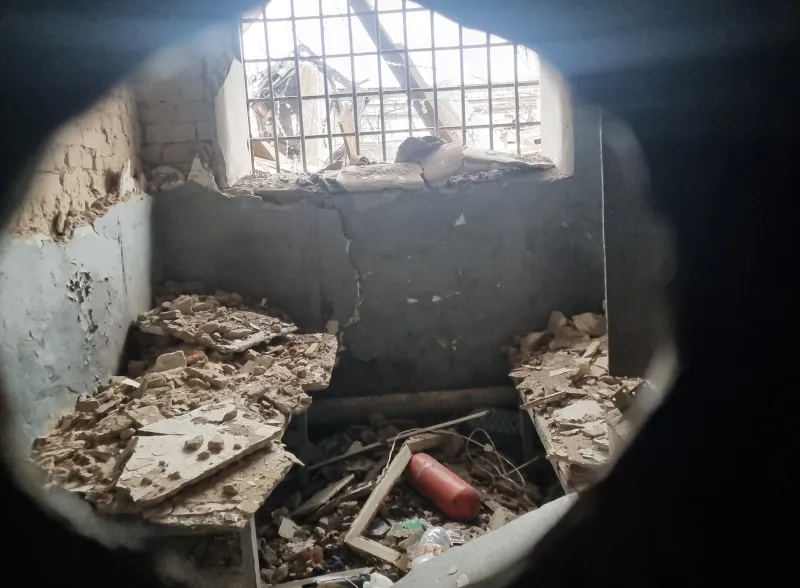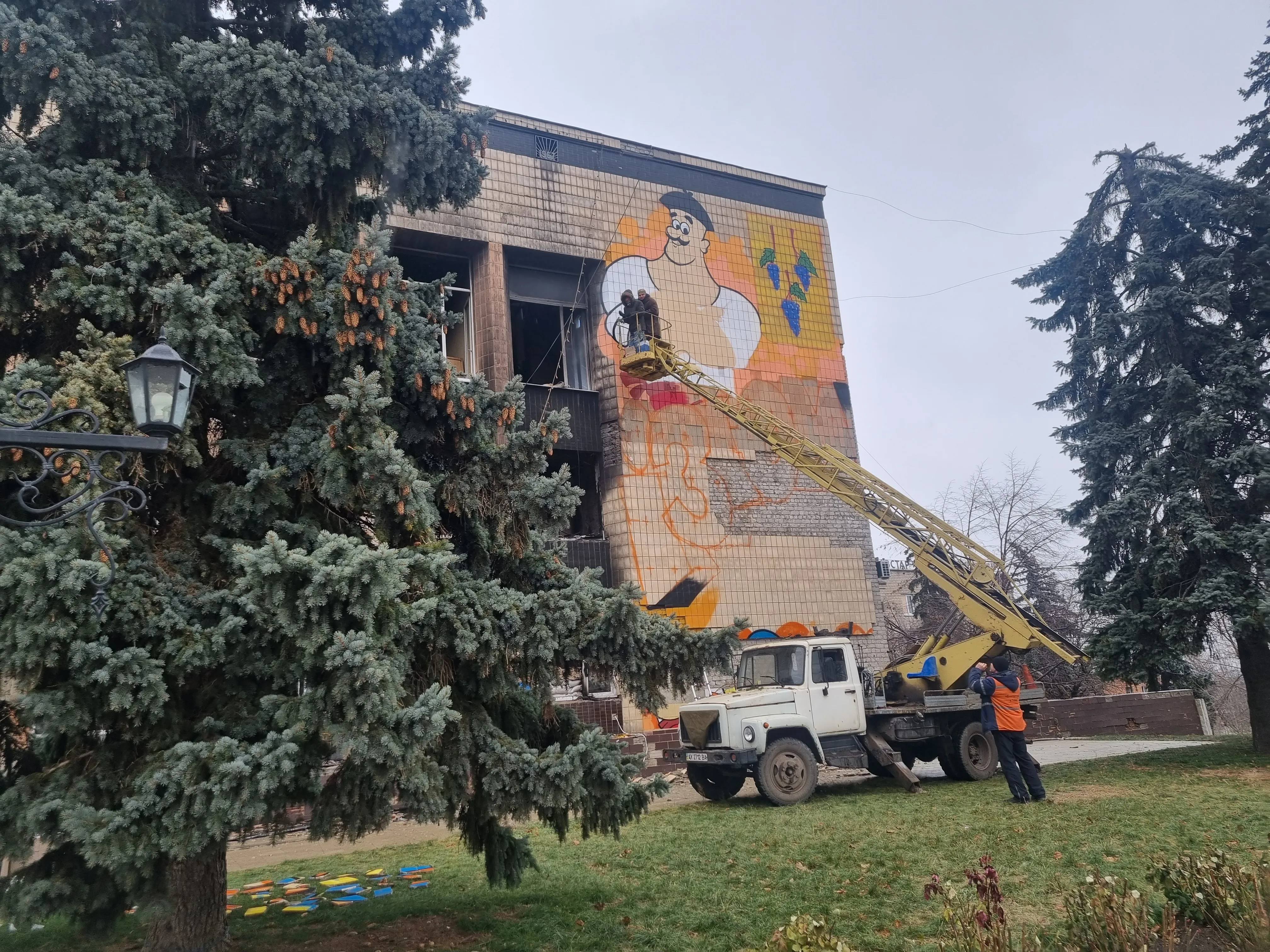
Kyiv, Ukraine, Dec 12, 2022 / 09:30 am (CNA).
There was a popular Ukrainian cartoon series in Soviet times about three Cossacks. They represented a sort of “Ukrainian Popeye” — a Cossack as a man with a mustache and muscles, testifying to the greatness of the Ukrainian people.
The image of the free-wheeling Cossacks, proud riders of the Eurasian steppe, has captured the imagination of countless minds over the centuries, and perhaps nowhere more than in Ukraine.
There was a mural of this popular image on the Union House in the central square of Izium, in eastern Ukraine.
The Russians destroyed the building during the battle of Izium that took place between March 3 and April 1. Then, Russians occupied the city for months. Izium was taken back by Ukrainian forces in September. The first concern was restoring the mural — to rebuild one’s identity before rebuilding everything else from the rubble.

There is a lot to rebuild in the town of Izium. An estimated 80% of the taller buildings and 30% of private houses were destroyed in the fighting.
CNA recently traveled to Ukraine with a small delegation of Vatican reporters for a trip organized by the Polish and Ukrainian embassies to the Holy See. The trip offered a firsthand glimpse of the situation.
Some reports state that Ukrainian forces also bombed targets, including civilian buildings, due to the military presence. Even if true, it should be considered that the Ukrainians were attacking a city in Russian hands. The civilian buildings had been evacuated and were occupied by the military.
Such political and strategic details neither take away from — nor add to — the facts of what happened here: As part of the “Special Military Operation,” the Russians attacked from that frontier, finding, after Izium, an open countryside up to Kharkiv.
In Izium, the Russian invaders bombed a police post and used its destroyed basement as prison and torture chambers. Up to seven prisoners were crammed — in precarious hygienic conditions — into cells built for two. Those cellars had not been renovated and were not being used. Among the remains in those rooms are books and objects belonging to the prisoners. Some of them were women. Six rapes have been officially recognized. Other cases are still being investigated.
The bombs damaged even the hospital — the surgery department was hit. For months, doctors operated in the underground. Now the department is half functioning, though it can no longer care for children. It has about 70 patients.
In March, the Russian offensive knocked out practically an entire building wing in town. The shelling caused 51 deaths — five bodies were found immediately and others after various searches through the rubble. Among them were two children, one born in 2016 and one in 2019.
The buildings were ruined and the windows torn out, but the apartments, when they lasted, kept bits of life.

A woman arrives with two shopping bags on wheels and takes some of her belongings. A wardrobe has been left behind — it is still full of clothes. There is a playground with slides and swings — it, too, was hit by bombs. One wing of the building no longer exists, and Marian icons have been placed at the site in memory of the victims.
Izium is also a city of mass graves. Near a cemetery outside town, there are 447 graves, of which 425 are for civilians. These graves hold the remains of people who died in the bombings. The graves were later mined, and only after their demining could bodies be exhumed.
Izium is a martyr city. And yet, people continue to move forward and try to rebuild. There is still a curfew in place. There is also a curfew in Kharkiv, the region’s administrative center. It is a predominantly Russian-speaking city that lost many inhabitants during the war.
The curfew has been continued until 11 p.m. The Christmas Mass will be celebrated early to avoid going beyond the curfew, and in small groups, in various parishes, to prevent large gatherings of people.
“The Russians know our holidays well and may want to send a ‘gift,’ as they did with the missiles at Easter,” Bishop Pavlo Hončaruk of Kharkiv-Zaporizhzhia explained.
Though the city is predominantly Russian-speaking, many stopped maintaining Russian sympathies after the aggression. Forty children slept in the premises of the Armenian Catholic Church of the Assumption during the days of the siege.
Tina lives at a friend’s hotel. She has a 10-year-old daughter, and on March 3, she lost her house to the bombing and left, destined for Rieti, Italy. She stayed for a few months but had difficulty finding work. So she and her daughter came back, even homeless, because she missed it “too much.”
Such stories make it clear why the Ukrainian people continue to fight and struggle, not even considering surrendering, despite everything.
There are two detours on the route from Izium to Kharkiv due to a destroyed bridge and damaged road. Several military checkpoints and barricades hinder the trip. But there is traffic on the road — people have started moving again, albeit in the face of fear.
“The war will end in two or three months, when the West understands what we have done,” says the deputy head of the region’s military administration.
However massive the commitment of forces and weapons against Russia, the question remains whether it will be enough.
The soldiers don’t know the answer — and neither do the chaplains, who go to the front every day to say Mass in a discreet, almost hidden way. They will do so even at Christmas.
This year will be a difficult Christmas, and the bishop also underlines that it is necessary to see Jesus in the enemy, especially this Christmas. But what to do when the enemy has raped, committed violence, and hasn’t asked for forgiveness?
“It’s not rational. It’s something that I have to experience first in my life. I have stopped challenging God with why all this happens, even if — at times — I am discouraged. I am called to believe,” the bishop replied.
Izium, Kharkiv, and the whole region still bear open wounds. A few hours after the visit of the delegation of journalists, another attack left four injured. And yet, in the bishop’s words, there is the first tentative foothold for hope.
If you value the news and views Catholic World Report provides, please consider donating to support our efforts. Your contribution will help us continue to make CWR available to all readers worldwide for free, without a subscription. Thank you for your generosity!
Click here for more information on donating to CWR. Click here to sign up for our newsletter.






Leave a Reply